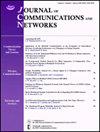On the performance of uplink power-domain NOMA with imperfect CSI and SIC in 6G networks
IF 3.2
3区 计算机科学
Q2 COMPUTER SCIENCE, INFORMATION SYSTEMS
引用次数: 0
Abstract
Sixth generation (6G) networks must adopt spectral-efficient communication techniques to ensure massive connectivity for coexisting humans and machines. However, the impact of various practical issues must be analyzed and addressed, including imperfect channel state information (CSI), stemming by the channel estimation error (CEE) and feedback delay (F-D) with time-variant channels. This paper focuses on these issues in the context of uplink networks, relying on power-domain nonorthogonal multiple access (NOMA). Moreover, the degrading effect of imperfect successive interference cancellation (SIC), when randomly deployed multiple mobile terminals communicate with a single base station (BS) is considered. The system performance is measured by means of outage probability, error probability, ergodic rate, throughput, energy efficiency, and spectral efficiency. Analytical, asymptotic, and computer simulation results demonstrate that CEE causes system coding gain losses for low signal-to-noise ratio (SNR) while the disruptive effects of CEE become negligible in the high SNR. Results also show that F-D does not degrade the system performance in the low SNR but it causes system coding gain losses for high SNR. Also, imperfect SIC does not have any detrimental effect on the system performance for low SNR but results in reduced coding gain for high SNR.论 6G 网络中具有不完美 CSI 和 SIC 的上行功率域 NOMA 性能
第六代(6G)网络必须采用具有频谱效率的通信技术,以确保人机共存的大规模连接。然而,必须分析和解决各种实际问题的影响,包括不完善的信道状态信息(CSI)、信道估计误差(CEE)和时变信道反馈延迟(F-D)。本文以上行链路网络为背景,依靠功率域非正交多址接入(NOMA),重点讨论了这些问题。此外,本文还考虑了当随机部署的多个移动终端与单个基站(BS)通信时,不完善的连续干扰消除(SIC)所带来的衰减效应。系统性能通过中断概率、错误概率、遍历率、吞吐量、能效和频谱效率来衡量。分析、渐近和计算机仿真结果表明,CEE 在低信噪比 (SNR) 时会造成系统编码增益损失,而在高信噪比时,CEE 的破坏性影响可以忽略不计。结果还显示,F-D 在低信噪比时不会降低系统性能,但在高信噪比时会造成系统编码增益损失。此外,不完善的 SIC 在低信噪比时不会对系统性能产生任何不利影响,但在高信噪比时会导致编码增益降低。
本文章由计算机程序翻译,如有差异,请以英文原文为准。
求助全文
约1分钟内获得全文
求助全文
来源期刊
CiteScore
6.60
自引率
5.60%
发文量
66
审稿时长
14.4 months
期刊介绍:
The JOURNAL OF COMMUNICATIONS AND NETWORKS is published six times per year, and is committed to publishing high-quality papers that advance the state-of-the-art and practical applications of communications and information networks. Theoretical research contributions presenting new techniques, concepts, or analyses, applied contributions reporting on experiences and experiments, and tutorial expositions of permanent reference value are welcome. The subjects covered by this journal include all topics in communication theory and techniques, communication systems, and information networks. COMMUNICATION THEORY AND SYSTEMS WIRELESS COMMUNICATIONS NETWORKS AND SERVICES.

 求助内容:
求助内容: 应助结果提醒方式:
应助结果提醒方式:


